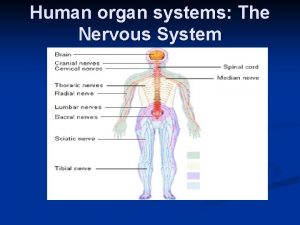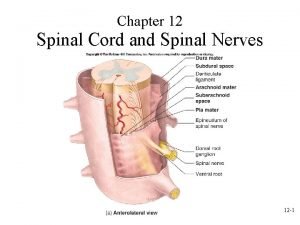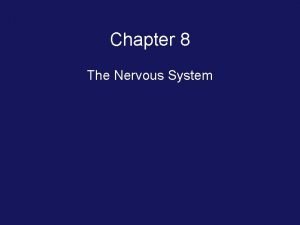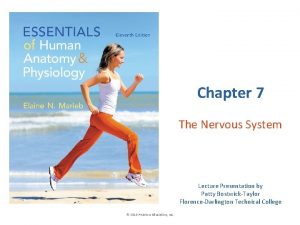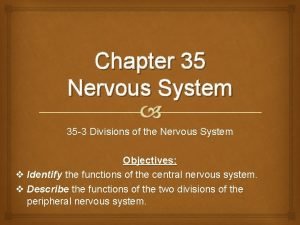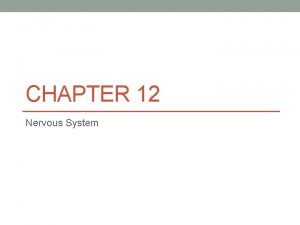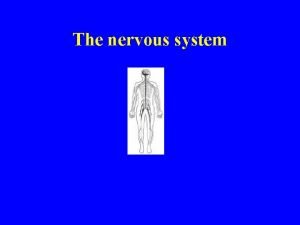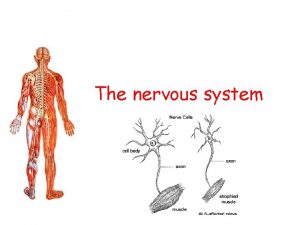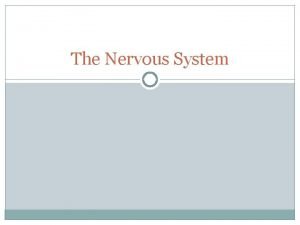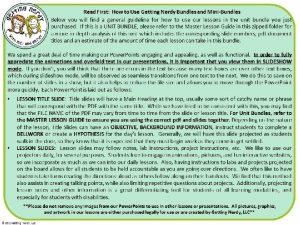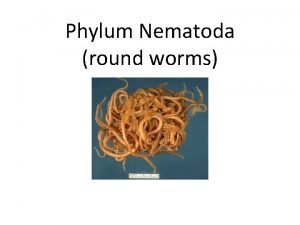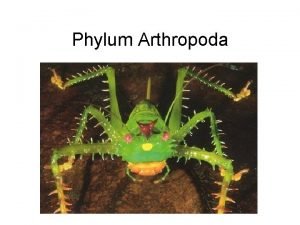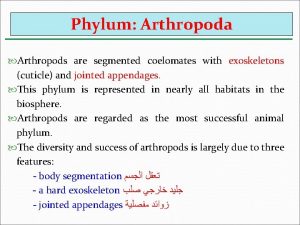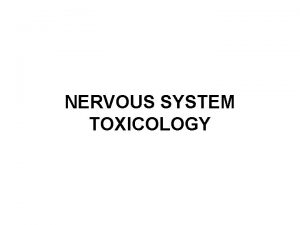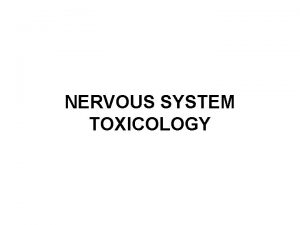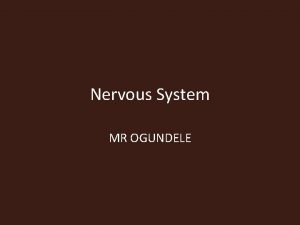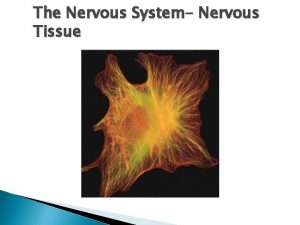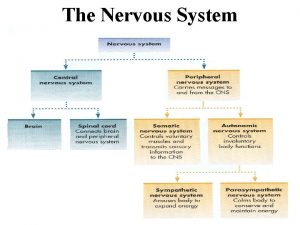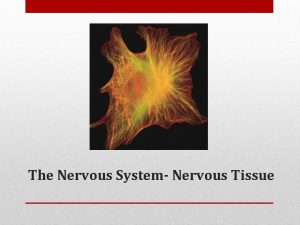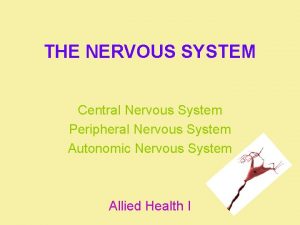The Nervous System Chapter 11 Unit 2 A




































- Slides: 36


The Nervous System Chapter 11 Unit 2 • A system that controls all of the activities of the body. • It is complex and somewhat difficult system to understand • Your brain is the boss of your body. It runs the show and controls just about everything you do, even when you're asleep, but also many things you're less aware of — such as the beating of your heart, the digestion of your food, and yes, even the amount of stress you feel. Like you, your brain is quite the juggler.

The Nervous System • The system has two main divisions: 1 -The central nervous system(CNS): Which consists of the brain and the spinal cord 2 -The peripheral nervous system: Which includes all the nerves of the CNS to every organ and the rest of the body

Peripheral Nervous System The PNS relays information to and from the central nervous system, and the brain is the center of activity, and makes us the individuals we are The Autonomic nervous system is a part of the peripheral nervous system(talk about later)

The Nervous System • What does the Center nervous system consist of? • Brain and spinal cord • What does the Peripheral nervous system consist of? • Nerves

The Nervous System • The nerve cell or neuron is the functioning unit in this system The human brain has approximately 100 billion neurons.

The Nervous System • There are three types of neurons 1. Sensory: Send signals to the sensory receptors(skin, eyes, nose, tongue, ear) example ice on your hand 2. Connecting: (Interneuron)Send information between sensory neurons and motor neurons. example they act as highways or bridges connecting neurons within the brain and spinal cord. 3. Motor: send signals to muscles or glands. Example when your get into your car the brain tells you to put the key in an turn it

The Nervous System • The nerve cell or neuron has a nucleus, cytoplasm, and a cell membrane • The cell body has processes that are extensions of cytoplasm called dendrites and axons

The Nervous System Axons Dendrites Take information away from the cell body Bring information to the cell body Have a smooth surface Have a rough surface Only one axon per cell Many dendrites per cell No ribosome Have myelin No myelin Branch far from the cell Branch near the cell body

Membrane Excitability • Nerves carry impulses by creating electric charges in a process known as membrane excitability • This whole process occurs in a few millisecond • When the action occurs in one part of the cell membrane of the neuron, it spreads to the other parts of the membrane sending messages

Membrane Excitability • The impulses travel across a neuron from the dendrites to the cell body and then to the axon

Parts of a Neuron • The cell body contains the nucleus • Dendrites are processes(extensions) that transmit impulses toward the cell body • Axon transmit impulses away from the cell body • Schwann cells grow to surround the neuron(several layers in the peripheral nervous system)nerves • Myelin Sheath insulating layer that forms around nerves, a fatty substance


Membrane Excitability • But what happens when the impulse reaches the end of the neuron • There is a minute space between the dendrite of the neuron called a synapse, which the impulse must jump chemically

Facts • Normally nerve impulses travel about 200 miles per hour • The intake of alcohol seems to aid the chemical that causes impulse to be blocked, and our reactions are slowed down • Serotonin is an inhibitory neurotransmitter that has been found to be involved in emotion and mood. Too little serotonin has been shown to lead to depression(depression medication releases serotonin)

Peripheral Nervous System And Spinal Cord • The peripheral nervous system includes 12 pairs of cranial nerves that connect the brain directly to the sense organs(eye, ears, tongue, nose, and skin), the heart, the lungs, and other internal organs(picture on next slide) • The peripheral nervous system also includes 31 pairs of spinal nerves, they provide function or movement, an sensory stimuli


Autonomic Nervous System • The autonomic nervous system is part of the peripheral nervous system • These nerves are involuntary and unconscious regulate functions such as breathing, heartbeat, and digestion • There are two divisions of the autonomic system • 1. The sympathetic division accelerates activity in the smooth, involuntary muscles of the body’s organs, "fight-or-flight" reaction to emergencies, increases heart rate and blood pressure • 2. The parasympathetic division reveres the action and slows down activity, “rest and digest” body's calming and relaxing functions

Central Nervous System • Scientists call the brain the most complex and challenging structure ever studied • This small organ weighs about 3 pounds, is a mass of interconnecting nerve cells that “talk” to each other continuously

The Structure and Function Of The Brain • The brain is divided into five parts: • 1. The largest is the cerebrum

Cerebrum • 1. The largest is the cerebrum which controls sensory and motor activities • The cerebrum is further divided into lobes

Frontal Lobe • The frontal lobes are considered our emotional control center and home to our personality and speech

Occipital Lobe • The occipital lobes are the center of our visual perception system. These areas “see”

Parietal Lobes • Between the frontal and occipital lobes is the parietal lobes(2) • The largest portions areas are for sensation in the hands and face, the taste areas, which overlap the temporal lobes, receive impulses from the taste buds • The left area is for the right side of the body and vice versa(stroke)

Temporal Lobes • The olfactory areas in the temporal lobe(2) receive impulses from receptors in the nasal cavities for the sense of smell and to the auditory areas to the inner ear for hearing and for speech

Cerebellum • The cerebellum is located just above the brainstem, beneath the occipital lobes at the base of the skull • The functions of the cerebellum are concerned with involuntary movements (walking, dancing) and equilibrium

Medulla Oblongata • The medulla extends from the spinal cord to the ponds. Its functions are those we think of as vital signs(blood pressure, respiration, pulse) and are reflex center for coughing, sneezing, swallowing, and vomiting. • Any injury to the medulla would be fatal

Pons • The pons bulges anteriorly from the upper part of the medulla • The pons works together with the medulla to produce a normal breathing rhythm • It is also the reflex center for chewing, tasting, and secreting saliva

Thalamus • The thalamus is superior(above) to the hypothalamus • Many of the functions are concerned with sensation • The basic thalamus function in the brain is to process and relay movement and sensory information

• • • Hypothalamus The hypothalamus is located inferior(below) the thalamus This a small area of the brain with many diverse functions Produces ADH(antidiuretic hormone; helps with kidneys reabsorb water) and Oxytocin(bring about childbirth) Produces(many hormones) growth hormone-releasing hormones Regulates body temperature(Homeostasis) Regulation of food intake(says your full) Helps the functioning of the autonomic nervous system(vital signs) Stimulates emotions(blush when embarrassed, angry the heart races) Regulates sleep cycle, changes in mood, mental alertness(biological clock; circadian rhythms also means “about a day”)

Meninges • The connective tissue that covers the brain and spinal cord are called meninges

Cerebrospinal Fluid • The cerebrospinal fluid is the tissue fluid of the central nervous system • Helps cushion the brain and spinal cord • CSF protects brain and spinal cord from trauma. • CSF supplies nutrients to nervous system tissue. • CSF removes waste products • Hydrocephalus is a buildup of fluid inside the skull that leads to brain swelling. • Hydrocephalus means "water on the brain. "

Diagnostic Tests • Electroencephalogram(EEG): A brain wave test that measures the brain’s electrical signals • For stroke, seizures, infections, or injuries

Diagnostic Tests • Lumbar puncture- A spinal needle is inserted into the spine and cerebral spinal fluid is removed (meningitis) • Skull x-ray- To identify fractures and dense areas that indicate a tumor or increased pressure within the skull

Disease And Disorders • Alzheimer’s Disease: This is a progressive, degenerative disease that attacks the brain, gradual memory loss, personality change, inability to care for self. • Cerebral Palsy: This disorder is a nonprogressive brain injury that occurs during fetal development, or in early infancy(lack of oxygen), they have permanent muscle shorting

Disease And Disorders • Epilepsy: A seizure disorder, it is associated with abnormal electrical impulses from the neurons of the brain, causes brief changes in movement, behavior, sensation, or awareness • Its believed to be caused by either prematurity(lack of oxygen), injury, tumors, or meningitis • Headache: Are classified as vascular, muscle contractions, most are from tension
 Fundamentals of the nervous system and nervous tissue
Fundamentals of the nervous system and nervous tissue Sensory input and motor output
Sensory input and motor output Nerve cell process
Nerve cell process Basic unit of nervous system
Basic unit of nervous system What is a pathogen
What is a pathogen Division of spinal cord
Division of spinal cord Nervous system and digestive system
Nervous system and digestive system Endocrine system vs nervous system
Endocrine system vs nervous system Mechanism of hormone action
Mechanism of hormone action Endocrine system and nervous system
Endocrine system and nervous system Bipolar neuron function
Bipolar neuron function Chapter 15 nervous system diseases and disorders
Chapter 15 nervous system diseases and disorders Chapter 8 the nervous system
Chapter 8 the nervous system Chapter 7 the nervous system figure 7-2
Chapter 7 the nervous system figure 7-2 Chapter 35 nervous system
Chapter 35 nervous system Chapter 14 skeletal muscular and nervous systems
Chapter 14 skeletal muscular and nervous systems Chapter 12 nervous system
Chapter 12 nervous system Unit 10, unit 10 review tests, unit 10 general test
Unit 10, unit 10 review tests, unit 10 general test Chemical messengers of the nervous system
Chemical messengers of the nervous system Platyhelminthes segmentation
Platyhelminthes segmentation The nervous system is made up of
The nervous system is made up of Neuron anatomy
Neuron anatomy Learning objectives of nervous system
Learning objectives of nervous system Stimulus in nervous system
Stimulus in nervous system Nervous system objectives
Nervous system objectives Parasympathetic and sympathetic
Parasympathetic and sympathetic Ans
Ans Spinal nerve pairs
Spinal nerve pairs Sns somatic nervous system
Sns somatic nervous system The nervous system brain scienstructable
The nervous system brain scienstructable Autonomic nervous system pathway
Autonomic nervous system pathway Nematoda
Nematoda Arthropoda
Arthropoda Chelicerates antennae
Chelicerates antennae Nervous system of arthropods
Nervous system of arthropods Division of nervous system
Division of nervous system Parasympathatic nervous system
Parasympathatic nervous system



